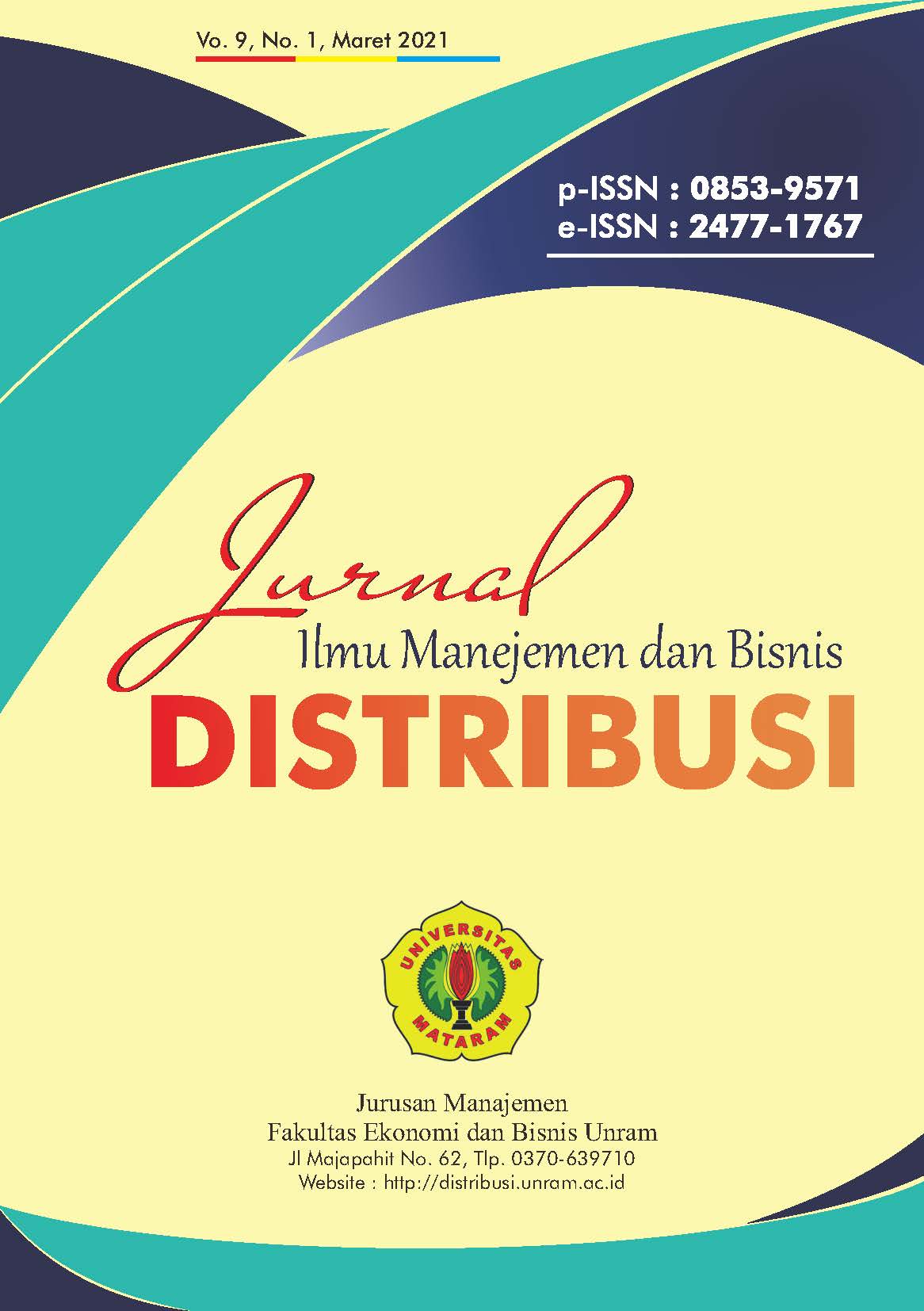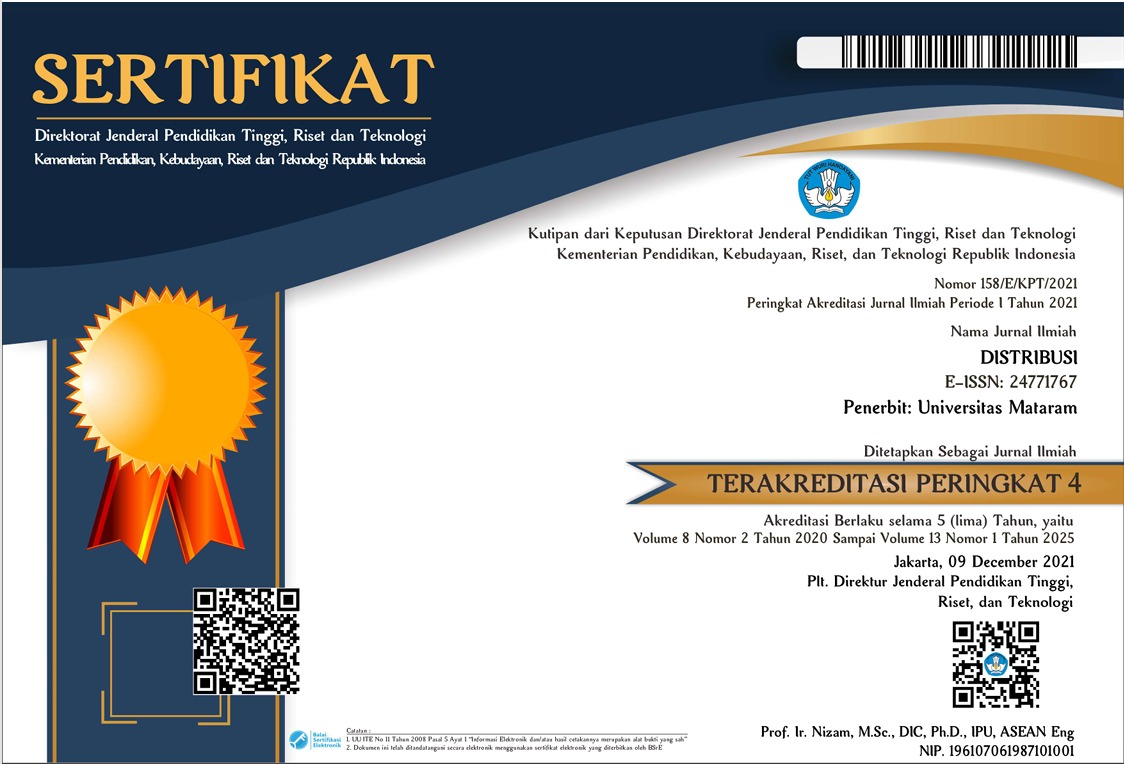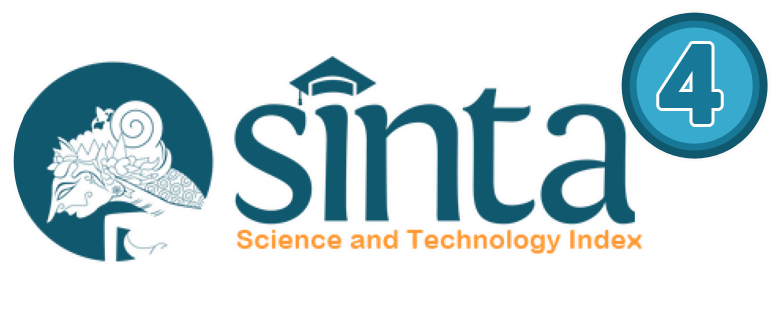PENGARUH KOMITMEN ORGANISASI DAN KETERLIBATAN KERJA TERHADAP KINERJA PEGAWAI DENGAN MOTIVASI SEBAGAI VARIABEL INTERVENING (Studi Pada Kantor Kecamatan Rasanae Barat Kota Bima)
DOI:
https://doi.org/10.29303/distribusi.v9i1.142Keywords:
Employee Performance, Motivation, Organizational Commitment, Work Involvement.Abstract
This study aims to: (1) Test and analyze the effect of organizational commitment on employee performance at the Rasanae Barat Sub-District Office in Bima City (2) Test and analyze the effect of work involvement on employee performance in the Rasanae Barat Sub-District Office in Bima City. (3) Test and analyze the effect of organizational commitment on motivation at the Rasanae BaratSub-District Office in Bima City. (4) Test and analyze the effect of work involvement on motivation at the Rasanae BaratSub-District Office in Bima City. (5) Test and analyze the effect of motivation on employee performance at the Rasanae Barat Sub-District Office in Bima City.
This research is a quantitative research. The population in this study were all employees working in the Rasanae Barat District Office in Bima City as many as 112 people. Determination of the sample by using the Slovin formula in order to obtain a sample of 88 people. Sampling method used was a simple random sampling technique and each employee has the same possibility to be selected as a sample. The instrument reliability test includes a validity test and a reliability test. The model that used in this research is a model of causality or relationship or influence and to test the proposed hypothesis, the analysis technique used was quantitative analysis with a path analysis approach.
The results of the study show that (1) There is an influence of organizational commitment on employee performance at the Rasanae Barat Sub-District Office in Bima City with a significance value of 0.021 less than 0.05 (significant). (2) There is an influence of work involvement on employee performance at the Rasanae Barat Sub-District Office in Bima City with a significance value of 0.015 which is less than 0.05 (significant). (3) There is an influence of work organization commitment to motivation at the Rasanae Barat Sub-District Office in Bima City with a significance value of 0.004 which is less than 0.05 (significant). (4) There is no influence of work involvement on motivation in the Rasanae Barat Sub-DistrictOffice in Bima City with a significance value of 0.331 which is greater than 0.05 (not significant). (5) There is a motivational effect on employee performance at the Rasanae Barat Sub-District Office in Bima City with a significance value of 0.041 which is less than 0.05 (significant).
Downloads
References
As’ad, Moh. (2012). Psikologi Industri : Seri Ilmu Sumber Daya Manusia. Yogyakarta : Liberty.
Amir, Faisal. (2015). Memahami Evaluasi Kinerja Karyawan. Jakarta : Mitra Wacana Media.
Azwar, S. (2015). Reliabilitas dan validitas.Yogyakarta: Pustaka Pelajar.
Akinbobola, O.I. 2011. Conflict in Human Capital relationships: the Impact of Job Satisfaction on Job Involvement in a workplace. International journal of Social Science and Humanity. Vol. 1(2)
Arsawan, E, W, I dan Wirga, W, I. (2012). Keterlibatan Karyawan : Strategi Meningkatkan Kinerja Karyawan. Jurnal Bisnis dan Kewirausahaan.Vol.8.
Colquitt. et. al. (2011). Organizational Behavior. New York : McGraw-Hill
Davis, Gordon. B. (2013). Kerangka Dasar Sistem Informasi Manajemen. Palembang:Maxikom.
Darrmawati, Khomsiyah dan Rahayu. (2010). Hubungan Corporate Governance dan Kinerja Perusahaan. Jurnal Riset Akuntansi Indonesia. Vol. 2 : 1-13.
Faslah, Roni. (2010). Hubungan antara Keterlibatan Kerja dengan Turnover Intention pada Karyawan PT. Garda Trimitra Utama Jakarta. Jurnal Fakultas Ekonomi Universitas Negeri Jakarta. EconoSains .Vol. VIII (2).
Gomes, Faustino Cardoso. (2013). Manajemen Sumber Daya Manusia. Jakarta: Andi Offset.
Handoko, T. Hani. (2015). Manajemen Personalia dan Sumber Daya Manusia. Edisi Kedua. Yogyakarta : BPFE .
Hasibuan, Malayu. S. P. (2016). Manajemen Sumber Daya Manusia. Edisi Revisi. Jakarta : Bumi Aksara.
Ivancevich et. Al. (2014). Organizational Behaviour. New York : Mc Graw-Hill Company.
Kismono, Gugu. (2011). Pengantar Bisnis. Edisi Kedua. Yogyakarta : BPFE UGM.
Kaswan. (2015). Manajemen Sumber Daya Manusia Untuk Keunggulan Bersaing Organisasi. Yogyakarta : Graha Ilmu.
Luthans, Fred. (2014). Perilaku Organisasi. Yogyakarta : Andi.
Mangkunegara, Anwar. P. (2016). Manajemen Sumber Daya Manusia. Bandung : PT. Remaja Rosdakarya.
Manullang, A dan Manulang, Marihot. (2014). Dasar-dasar Manajemen. Jakarta : Ghalia Indonesia.
Mathis, Robert.L dan John. H, Jackson. (2012). Manajemen Sumber Daya Manusia. Edisi Pertama. Jakarta : Salemba Empat.
Newstrom, J.W. (2011). Perilaku dalam Organisasi. Jilid 1. Terjemahan. Jakarta: Erlangga.
Prawirosentono. (2012). Filosofi Baru tentang Manajemen Mutu Terpadu. Jakarta : Gramedia Pustaka Utama.
Rahmadita Irma. 2013. Hubungan Antara Konflik Peran Ganda Dan Dukungan Sosial Pasangan Dengan Motivasi Kerja Pada Karyawati Di Rumah Sakit Abdul Rivai Berau. eJurnal Psikologi. Vol. 1 (1) : 58-68
Sani, Ahmad dan Maharani, Vivin. (2013). Metodologi Penelitian Manajemen Sumber Daya Manusia :Teori, Kuesioner, dan Analisis Data. Malang: Uin Press.
Schermerhorn, et. al. (2013). Manajemen Sumber Daya Manusia. Jakarta : Kencana Prenada.
Singarimbun, MasridanSofian, Effendi. (2010). Metode Penelitian Survei. Jakarta :Pustaka LP3ES Indonesia.
Sopiah. (2013). Perilaku Organisasi. Yogyakarta : Andi.
Sugiyono. (2016). Metode Penelitian Pendidikan Pendekatan Kuantitatif, Kualitatif dan R & D. Bandung: Alfabeta
Simanjuntak, B.H. dan Raharja. (2013). Faktor-Faktor yang Mempengaruhi Kelengkapan Pengungkapan Laporan Keuangan pada Perusahaan Manufaktur yang Terdapat di Bursa Efek Jakarta”, Jurnal Riset Akuntansi Indonesia, Vol. 7 (3) : 351-366.
Yekti. (2011). Pengaruh Kreativitas, Kemandirian Siswa, dan Lingkungan Tempat Tinggal Terhadap Minat Berwirausaha Siswa Kelas XI Program Keahlian Akutansi SMK Muhamadiyah 2 Wonogiri. Laporan Penelitian. UNY
Downloads
Published
How to Cite
Issue
Section
License
Copyright (c) 2021 Khairul Amar, Meutia, Diswandi

This work is licensed under a Creative Commons Attribution-ShareAlike 4.0 International License.
Penulis yang naskahnya diterbitkan menyetujui ketentuan sebagai berikut:
- Hak publikasi atas semua materi naskah jurnal yang diterbitkan/dipublikasikan dalam situs Jurnal DISTRIBUSI ini dipegang oleh dewan redaksi dengan sepengetahuan penulis (hak moral tetap milik penulis naskah).
- Ketentuan legal formal untuk akses artikel digital jurnal elektronik ini tunduk pada ketentuan lisensi Creative Commons Attribution-ShareAlike (CC BY-SA), yang berarti Jurnal DISTRIBUSI berhak menyimpan, mengalih media/format-kan, mengelola dalam bentuk pangkalan data (database), merawat, dan mempublikasikan artikel tanpa meminta izin dari Penulis selama tetap mencantumkan nama Penulis sebagai pemilik Hak Cipta.
- Naskah yang diterbitkan/dipublikasikan secara cetak dan elektronik bersifat open access untuk tujuan pendidikan, penelitian, dan perpustakaan. Selain tujuan tersebut, dewan redaksi tidak bertanggung jawab atas pelanggaran terhadap hukum hak cipta.









